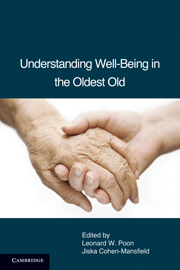Book contents
- Frontmatter
- Contents
- List of Tables
- List of Contributors
- Foreword by Carol D. Ryff
- PART I THEORY: NEW HORIZONS IN WELL-BEING RESEARCH
- PART II PARADISE LOST: BETWEEN TRAUMA AND HAPPINESS
- PART III PATHWAYS AND GATEKEEPERS: MODERATING, MEDIATING, AND PROXIMAL PROCESSES
- 9 Impact of Resources on Successful Adaptation among the Oldest Old
- 10 Nutrition and Well-Being
- 11 Cognitive Functioning and Vitality among the Oldest Old: Implications for Well-Being
- 12 Social Relationships and Well-Being in Very Late Life
- 13 Spirituality and Religiosity Connections to Mental and Physical Health among the Oldest Old
- 14 The Impact of Leisure Activity and Innovation on the Well-Being of the Very Old
- PART IV SIGNPOSTING PARADISE: MEASUREMENT OF WELL-BEING
- Index
- References
12 - Social Relationships and Well-Being in Very Late Life
Published online by Cambridge University Press: 05 August 2012
- Frontmatter
- Contents
- List of Tables
- List of Contributors
- Foreword by Carol D. Ryff
- PART I THEORY: NEW HORIZONS IN WELL-BEING RESEARCH
- PART II PARADISE LOST: BETWEEN TRAUMA AND HAPPINESS
- PART III PATHWAYS AND GATEKEEPERS: MODERATING, MEDIATING, AND PROXIMAL PROCESSES
- 9 Impact of Resources on Successful Adaptation among the Oldest Old
- 10 Nutrition and Well-Being
- 11 Cognitive Functioning and Vitality among the Oldest Old: Implications for Well-Being
- 12 Social Relationships and Well-Being in Very Late Life
- 13 Spirituality and Religiosity Connections to Mental and Physical Health among the Oldest Old
- 14 The Impact of Leisure Activity and Innovation on the Well-Being of the Very Old
- PART IV SIGNPOSTING PARADISE: MEASUREMENT OF WELL-BEING
- Index
- References
Summary
ABSTRACT
This chapter examines social networks and social exchange in relation to morale and survival among older Jewish Israelis. Using empirical data, the presentation shows that embeddedness in robust social networks and provision of help both decrease as age and disability increase. However, persons who retain robust networks and those who give help have better morale and greater likelihood of 7-year survival. The data underscore the great diversity that prevails among the oldest old.
INTRODUCTION
Study of the association between social relationships and well-being in very old age is an important undertaking. Social relationships are believed to affect well-being and the quality of late life. However, various aspects of social relationships can be considered measures of well-being in their own right, a means through which one may enhance his or her quality of life, or both. It is necessary, therefore, to better understand the ways in which these two domains – social relationships and well-being – are associated and to elucidate the nature of their relationship among the oldest old.
This chapter examines the association of social relationships and well-being in very late life, looking particularly at data that describe the life situations of older Israeli adults. Two interrelated aspects of social relationships are considered in this regard. First is the notion of social network, or the degree to which one is embedded in a structure of social ties.
- Type
- Chapter
- Information
- Understanding Well-Being in the Oldest Old , pp. 213 - 226Publisher: Cambridge University PressPrint publication year: 2011
References
- 1
- Cited by



